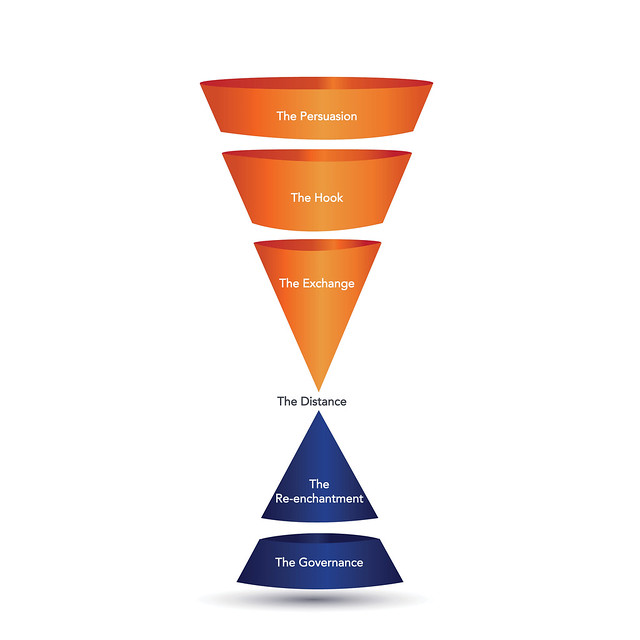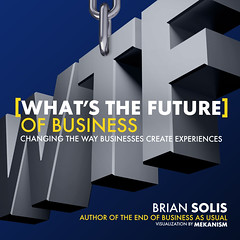
Over the years, businesses have developed sales, marketing and service strategies around the funnel. Awareness, interest, desire, action, to this day, describes the likely steps a customer may take in making a decision. Over the years, it was assumed that the liner path would also continue through a transaction to a state of loyalty and ultimately advocacy. The process of customer engagement to this day is designed to shepherd people along this delicate path. For at any moment, consumer attention, interest, and resulting action could fall astray without superintendence.
I call this the “Cluster Funnel” and it’s meant to demonstrate how a customer lifecycle when viewed in aggregate is broken.
Without awareness there can be no consideration. Hence, businesses today invest to varying degrees and effectiveness in marketing, advertising, and communications strategies. To earn customer attention isn’t a switch that toggles on and off, it is a state of perpetual engagement. The blaring noise that customers continually experience has forced them to adapt. Second nature acts as a defense mechanism to tune out the constant barrage of marketing messages and clever campaigns. Awareness at the top of the funnel is elusive but never more important.
The Cluster Funnel from What’s the Future of Business

For the sake of this discussion, let’s assume that everyone understands the value of the funnel (or at least the idea of it) to attract customers and invest in long-term relationships. But what if businesses were investing their time and resources in the wrong places? What if where we think we can impress upon customers or get them to notice us is not at all where their attention is actually focused?
These are important and timely questions to answer as they will reveal a new journey to embark upon. The truth is that what we know and what we need to know are in fact separated by an unfolding reality that requires immediate intervention.
Your market has already been disrupted. Through an unforgiving series of technology revolutions paired with an era of individual empowerment, your customers are not only more informed, their expectations have matured. The “C” change in consumerism has ushered in a genre of connected consumers. As a result, your customers are learning about you or your competitors differently. How they make decisions does not at all follow a linear path. How they are influenced and in turn influence others is profound in its reach and effect. What was once simplistic, or overly simplistic depending on your point of view, representation of a fluted customer journey is in fact much more dynamic and connected.
Engagement is as much art as it is science. But to better understand the behavior of your connected customers or as I refer to them “Generation C,” takes practice of the social sciences from digital anthropology and psychology to sociology and ethnography. Understanding behavior exposes patterns in consumer activity that in of itself reveals new touch points. Appreciating how customers form and make decisions and why inspires empathy and creativity. This research will specifically point to what Altimeter Group refers to as the Dynamic Customer Journey. What you’ll learn following your research is everything. Most notably, your business will now earn clarity in how and where to focus efforts on shaping decisions and experiences pre-, during, and post commerce. Additionally, you’ll learn the specific factors, people, technology, communities, and resources that affect every stage of your customer’s journey. The results will contribute to a far more accurate point of view that tailors marketing, sales, service, and loyalty strategies to be more effective and engaging. But it won’t stop there.
Inspired by McKinsey’s work and my own research during the writing of The End of Business as Usual, we re-imagined the traditional funnel into a constant and very public elliptical path that often repeats itself.
1. Awareness
2. Consideration
3. Evaluation
4. Purchase
5. Experience
6. Loyalty
7. Advocacy
The stages of the Dynamic Customer Journey are familiar as they reflect similar methodologies in the traditional funnel. However each step is unique in the contributing factors for how consumers discover, analyze, choose, and share. The screens they use to search and purchase, the people who influence them, the content that informs them, the social networks they rely upon, the collective experiences of others, and the real-time conversations that shape impressions, each introduce guidance, doubt, and validation that works for or against your right now. The most important revelation in the DCJ is how every stage feeds into a discoverable online repository of shared experiences that influence all those who embark upon a similar journey. Without positive influence there is no hope for preference. And, without positive experiences there can be no chance for loyalty or advocacy.
It is only by traveling in the digital footsteps of your customers that uncovers a new landscape for engagement and also a new reality for your business. Embracing your connected customers will help them embrace you in return. At a minimum, the gifts you receive by embarking on this journey and investing in engagement, education, and meaningful experiences are empathy, relevance, and ultimately reciprocity…all of which is measurable by traditional business metrics.
The story continues…
Brian Solis
Connect with me: Twitter | LinkedIn | Facebook | Google+ |Youtube

